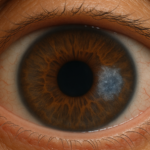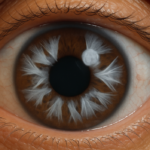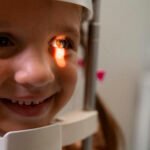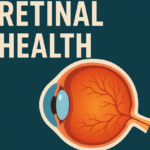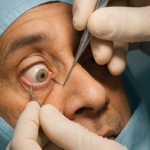Macular Degeneration
Age-related macular degeneration (AMD) is a common eye condition among people 50 years of age and older. It is the leading cause of vision loss in older adults. It gradually destroys the macula the part of the eye that provides sharp central vision needed for seeing objects clearly. There are two forms of AMD – dry and wet form.
Dry AMD is the most common form of AMD in the early or intermediate stages. It occurs in 90 % of the people with this condition. This happens when the light-sensitive cells in the macula slowly break down, gradually blurring central vision in the affected eye. As dry AMD progresses, a blurred spot develops in the center of vision and the patient may have trouble recognizing faces. Wet AMD affects about 10% of all people with AMD. This happens when the abnormal blood vessels start to grow in the region of the macula. These are fragile and tend to leak blood and fluid. The blood and fluid cause the macula to swell and damage occurs rapidly. Straight lines start appearing wavy in this condition.
The risk factors for this condition are smoking, Caucasian and Indian race, and family history of AMD. This can be detected by checkup of the visual acuity, fundus examination, Amsler grid test, and fundus fluorescein angiography. Treatment modalities include special anti-VEGF injections, lasers, and enhancing vision with low vision aids. Above the age of 65 years, a complete eye examination is advised every year to detect the problems early.
Diabetic Retinopathy
About 75 % of patients having diabetes more than 20 years develop diabetic retinopathy. This potentially blinding disorder is a complication of diabetes. Diabetic retinopathy is the most common form of diabetic eye disease. Retinopathy can affect all diabetics and becomes particularly dangerous, increasing the risk of blindness, if it is left untreated. The risk factors include poor blood glucose control, protein in the urine, high blood pressure, prolonged diabetes, and raised fats in the blood. Symptoms include double vision, blurred vision, pain in the eye, seeing spots, and loss of vision. Diabetes causes abnormal changes in the retina’s blood vessels. Blood vessels can become leaky and begin to grow where they should not. These new vessels tend to break and bleed, or hemorrhage. As they try to heal, these blood vessels will contract and lead to retinal detachment.
Diabetic Retinopathy Symptoms include shadows or dark objects that “float” across your field of vision, blurred or distorted vision, partial loss of vision, and pain in the eye. There is no cure for diabetic retinopathy. However, laser treatment (photocoagulation) is usually very effective at preventing vision loss if it is done before the retina has been severely damaged. Surgical removal of the vitreous gel (vitrectomy) may also help improve vision in case there is a vitreous hemorrhage. Anti-VEGF injections can be given when there is macular edema. Prevention is by performing eye tests once a year, control of blood sugar, maintaining healthy blood pressure, quitting smoking, and regular exercise.
Dry eyes
This is the result of a chronic lack of moisture on the eye’s surface. There can be two reasons for the eyes to become dry: one is that the composition of the tear film changes. This is particularly a problem when the lacrimal fluid contains too little oil because tears evaporate more quickly through the lack of a stabilizing lipid layer. The latter leads to a paradox: the eyes become watery yet feel dry. On the other hand, the problem can be due to the amount of lacrimal fluid produced. Tear production can be reduced as a result of various influences such that enough fluid is no longer present in order to keep the eyes evenly moist. In old age, both causes of dry eyes usually appear together: tear production decreases with increasing age, and the composition of the tear film changes.
Dry eyes should not be underestimated because they are subject to constant irritation due to the missing protective film. In addition, the eyes are significantly more susceptible to infection as the defense against pathogens is weakened. Fine damage can occur and can lead to scarring of the cornea. Dry eyes can lead to a gritty sensation, a foreign body feeling, and sometimes excess watering from the eyes. The surface epithelium becomes disturbed due to the dry eyes as evidenced by fluorescein staining.
Dry eyes can be improved with the following tips: drinking lots of water, air humidity should be maintained high and one should not strain the eyes. One should read and work on the computer in good light. Beta-blockers and antihistamines can lead to dry eyes. Menopause can also exacerbate the dry eye and these may need physician intervention. Treatment includes lifestyle modification, lid hygiene, and medication to lubricate the eyes and reduce inflammation.
Every elderly person should have a comprehensive eye examination performed by an ophthalmologist including checking the visual acuity, intraocular pressures, and a dilated eye examination.
Dr. Ramesh Murthy is one of the best eye specialists and one of the best cataract surgeons in Pune and he is available at Axis Eye Clinic which is one of the best eye clinics in Pune.




